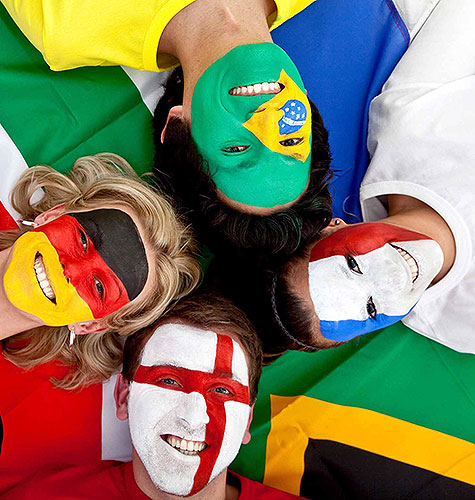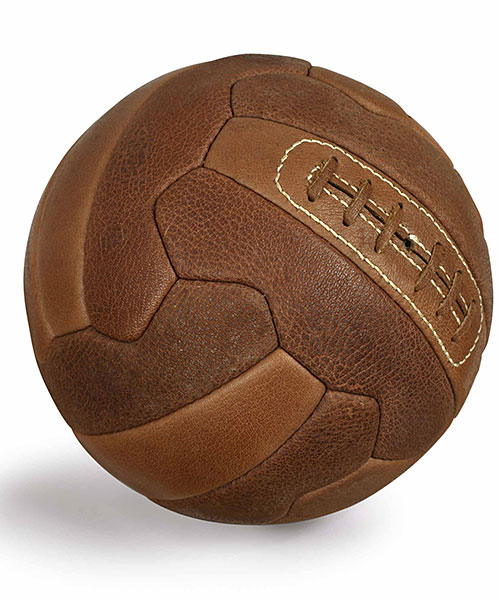Some historians believe that the origin of soccer was nearly three thousand years ago. Soccer has been played all over the world and there are many older games that hold similarities to the modern understanding of soccer. The roots of soccer are a bit ambiguous, but what is known of the sport suggests that it is a very old game that has evolved over the passage of time.




One cannot exactly point out as to when and where the game actually began. A lot of references agree that China is the birthplace of “kicking the ball”. Documentary evidence reveals that an organized activity resembling football transpired during the 2nd century BC in the reign of the Han Dynasty. The soldiers from the Chinese military used to play the game during their free time; kicking the ball into a small net. It is also reported that a field was set for playing the game of “ball-kicking” at Kyoto in Japan.
The resemblance of the current soccer-type game can be found in the game played by the ancient Greeks and Romans. The teams during those times consisted of up to 27 players. Britain is unarguably the place from which the modern soccer came into existence. In fact, the game caught the frenzy of the masses from the beginning of the 8th century. Football has always been termed as Soccer in Britain. Scotland and Britain together share the credit for being the co-founders of the organized sport.

Soccer is played with a lot of passion and enthusiasm in today’s age. However, in early days the game was played fiercely - almost akin to a war. Football was played in the name of honor, valor and manhood. It was used as a medium to settle scores with the enemies. It is reported that in medieval times, towns and hamlets played against rival towns and hamlets and indulged in punching, biting, kicking and cutting into the flesh of players during the course of the game. The only “goal” during those games was to move the ball to a pre-defined spot that was agreed upon before the game started. Players had to weather physical assaults and bodily harm, apart from playing the game, to reach that spot. The game was participated in by hordes of people and the game would last the entire day. Taking into account the violent dimensions of the game, there were many attempts made by authorities to ban Soccer. In 1331, King Edward III passed a law to suppress football. Scotland followed suit when King James 1, in 1424, sought to ban the game in his parliamentary speech. Queen Elizabeth 1 of England had reportedly passed a law by which the soccer players could be put in prison for a week and were thereafter ordered to observe penance in church. However, no law could stop the fervor of people toward the game. The game was too popular in Britain to be curbed.
In 1815, the renowned English school, Eton College, laid down a code of conduct regarding football for other schools and universities to follow. This set of rules came to be known as Cambridge Rules, which were diligently followed by most of the educational institutions by 1848. Football was now divided into two separate games - those who followed the Cambridge rules and those who followed the rules laid down by the Rugby school. The Rugby school allowed shoving, tripping, shin kicking and using hands while handling the ball. On October 26th, 1863, eleven clubs in London sent their body of eminent members for a federation meeting in the Freemason’s Tavern to streamline a single set of fundamental rules that would govern the matches played amongst them. The meeting was quite eventful, as it led to the creation of The Football Association. The Rugby school did not agree with the outcome and so there was a split on December 8th, 1863, where the Rugby Football and The Football Association parted ways. The Football Association laid down strict rules in 1869, which discouraged any kind of handling of the ball. This laid down the norm of the basic rule of Soccer that is the essence of the modern game.
On January 1st, 1878, Patrick Thistle, a leading Scottish football player, traveled to England for a match to be played against Darwen. Two prosperous mill owners, JC Ashton and Nathaniel Walsh, founded the Darwen club in 1871. One of Patrick’s best players, Fergus Sutler, wrote to the Darwen club secretary and stated that he wanted to settle in Lancashire and play for the club. His friend John Love, who was the goalkeeper for England, accompanied Fergus. Both joined the Darwen team and the club began to adopt the Scottish style of football which involved playing the game in the right and smooth manner with passes and proper positioning of the players rather than playing the game roughly and haphazardly. The new set of skills helped the team immensely and that became quite evident when Darwen drew a match in the 1879 FA cup against Old Etonians, veterans in the game. People began to appreciate the professional way in which the game was played by the Darwen club. Both Sutler and John became the first stars in the game of soccer.
The term “soccer” has an interesting piece of history attached to it. In the 1880s, the Oxford students developed a panache of using slang with an “er” added to the end of words they had purposely shortened. “Rugger”, for example, was slang for Rugby Football. The story goes that a student called Charles Wreford Brown was invited for a game of “Rugger”. His reply was, “No soccer!” He had actually abridged the word “Soc” from association, and added “er.” The term “soccer” was thus born, and Wreford Brown went on to play international football, or Soccer, for England.
In 1885, the professional way of playing the football was legalized by The Football Association, paving an eventful landmark in the history of Soccer. This move changed the way the game was played universally. Soccer became the greatest sport on the face of the planet. In 1888, William McGregor, a Scot, created the English Football League by asking 12 clubs to comply with a standard home and “away from home” fixture list. The director of Aston Villa club is credited with merging 12 clubs, namely:
- Accrington (Old Reds)
- Aston Villa
- Blackburn Rovers
- Bolton Wanderers
- Burnley
- Derby County
- Everton
- Notts County
- Preston North End
- Stoke City
- West Bromwich Albion
- Wolverhampton Wanderers
A Few Soccer Legends
Pelé - the greatest of all time.
Pelé is regarded by most observers as the ultimate hero of soccer. Strong, agile and quick, he scored over a thousand goals in his career and won three World Cups for Brazil. Bursting on to the scene during the 1958 World Cup in Sweden, the 17 year-old prodigy took the competition by storm, scoring six goals on the way to a memorable final, which Brazil won 5-2.
However, it is probably for the 1970 World Cup victory that Pelé is most fondly remembered. The Brazil side that won that final, 4-1 against Italy, is widely agreed to be the greatest team in the history of soccer. One of the most elegant of athletes, Pelé is surely the best soccer player ever to have played the game.
George Best - a prodigiously gifted winger.
George Best was not only a great hero of soccer but a cultural icon in his day. A swashbuckling winger in the great Manchester United team that won the European Cup in 1968, Best was the most naturally gifted, and arguably the greatest, soccer player of his time - two-footed, nimble and with a control of the ball that marked him out from more ordinary players. But, more than that, Best was a soccer icon – with his dashing good looks and playboy lifestyle, he became an emblem of the swinging London of the late 1960’s, and was linked with a string of beauties. His entry in the Hall of Fame gives a good account of his life and career.
Perhaps as a result of being the most famous soccer player in the world, George Best all but retired from the game in 1974 aged just 27, and it is for his time at Manchester United that he is best remembered as one of the most famous soccer players of all time. This 60’s hero of soccer tragically died in 2005 of complications from alcohol abuse.
Zinedine Zidane - a modern hero of soccer.
Of all the famous soccer players to have pulled on the jerseys of their country, perhaps none in modern times has been quite so inspirational as Zinedine Zidane. Born in France to Algerian parents, ‘Zizou’, as he is known, was a relatively late bloomer as a player, and although his talent was widely recognized among fans, it was not he captained France to the 1998 World Cup that the full extent of his talent became obvious.
Zidane is a true hero of soccer, particularly to the millions of immigrants in France, but also to fans and players from all over the world, who regard him as the best soccer player of the last twenty years.
Present Day Soccer
Today, soccer is a game that is played between two different teams. Each team consists of a total of eleven players and a regulation, spherical shape ball is used. By the beginning of the twenty-first century, the game was played in more than two hundred nations and by more than 250 million soccer players. This makes the game one of the most popular sporting pursuits on the entire globe to date. The game has been sometimes identified as “The World Game: suggesting the games popularity,” “The Beautiful Game:” suggestive of the game strategies and the attractive fields the games are played on; footie or footy, football, and most commonly, soccer. Presently, both men and women play this game and there are separate competitions for men and women involved in the sport.
Today, soccer games are played on a field that has fresh grass or an artificial turf. There is a goal positioned at each end of the field and in the middle of the field. Each team tries to make a goal by getting the ball to the opposing end of the field and into the goal area that is protected by a player from the opposing team. Goalkeepers are permitted to touch the soccer ball with their arms, body, and hands and all field players will control the ball with their feet, head, and torsos. Today, this game is governed by the FIFA or the International Federation of Association of Football. This organization is the agency that created the first World Cup competition. The agency supports and regulates a wide variety of competitions for both men and women too, including the men and women’s World Cup championships.